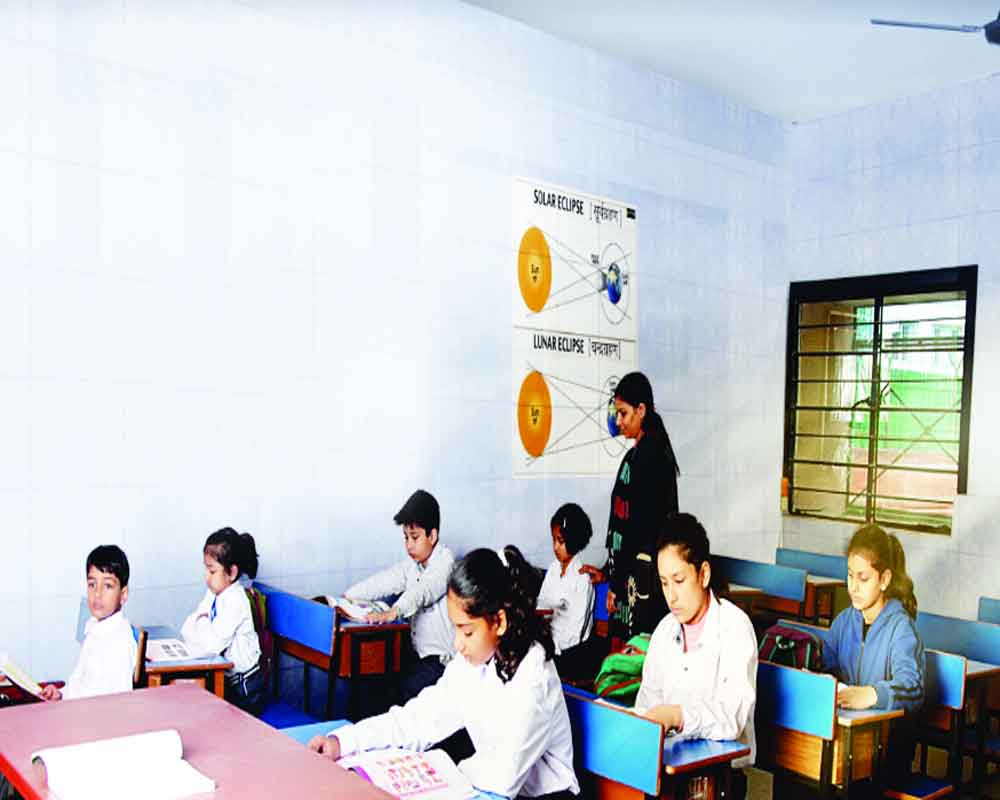By replacing chart papers and blackboards with digitally-printed tiles, government schools across the country are not only initiating sustainable education but creating a recall value for students as well as teachers, says Chahak Mittal
Imagine entering a school where you can touch and feel the numbers and alphabets, sense their character and simply discover the world around by running your fingers over the walls. Aradhana Agarwal, head of product development and CSR (corporate social responsibility) at Orient Bell Limited tiles in New Delhi, who has conceived digitally-printed tiles as a tool of learning in government schools, was inspired by normal children’s behaviour. She observed how kids, while walking around the corridors, normally rub their hands against the walls and bulletins which in turn damaged the paint and the chart papers on the boards. This became the basis of Ek Acha Bhavishya, where she decided that, “Instead of using electronic boards or simple tiles around, why not fill the tiles with content? Usually, the kids at government schools do not find the right atmosphere in their surroundings or at home to learn. In some cases, even in schools, they might not find the right exposure,” she said.
It was at a primary school at Til Begampur, Sikandrabad, Uttar Pradesh, that the first set of these tiles were installed in the premises. These make for informative and interactive visuals all around the walls and floors of the school building. There are also revamped classroom set-ups with educative yet aesthetically attractive digitally-printed tiles with numbers, diagrams, alphabets and maps plastered across the school. If that is not enough, washrooms are covered with patented germ-free tiles to ensure hygiene.
Recalling her own time in school, Aradhana said that there used to be bulletin boards across the classrooms and corridors, which were decorated with chart papers and cut-outs of different diagrams. However, they stayed only for a limited time span and needed a lot of time and new ideas to be re-decorated. “Also, children scrapped or tore off bits of those charts on the board. This is where the idea of creating and using informative tiles birthed from,” she said.
Aradhana, who had been teaching in primary schools for 10 years, started with Class I to understand the kind of content that should be printed. She said, “We referred to textbooks. We tried to dig out the things students normally wouldn’t want to read themselves from their books but would feel attracted to when they saw them projected on the walls. It would make them want to learn that. So we charted out what goes for which class. This way it kept on growing to higher classes.”
There could also be audio-visual teaching aids such as videos and guest lectures or 3D models like abacus and shape models in mathematics, alphabets models in English and interactive globes for Social Science.
However, the advantage of these tiles is that they last long and cannot be easily tampered with by students and thus are highly convenient teaching tools, which consume less time to convey information to the students. Ravindra Kumar, principal of the Til Begampur school, said, “Earlier, the teacher used to enter the class, draw the diagram or the map or write the tables on the board and the process would be time-consuming. Now, they can simply take forward the lessons. It enables a quick revision of topics and active visual learning while on the move.”
Another observation made by him was that during recesses, students would idle away their time in corridors. “Now, since the tiles attract them, they are much more involved. I have observed them moving around those tile charts in their spare time. They challenge each other to find out Rome in Italy’s map or other stuff like that. It has resulted in an increased retention of complex concepts and subjects,” he said.
Apart from the Til Begampur school, the tiles have been installed at five other centres in India, with constant efforts of making it reachable to as many government schools as possible. These are Prathamik Vidyalaya, Pisanharia Pratham in Varanasi; Primary School, Jokhababad, Bulandshahar; Rajkiya Madhyamik Vidhyalaya, Panchayawala in Jaipur; Shankar Dham Campus in Ahmedabad; and Nirmal Primary School, Connaught Place.
Looking at the data specifications from these schools, after the installation of these scribble-proof tiles, there has been a 36 per cent rise in enrollment of children in two years. While absenteeism has reduced by 31 per cent (from 52 per cent to 12 per cent), an improvement in results has also been observed.
However, since there is a dearth of proper infrastructure, competitive and committed teachers as well as quality education, especially in rural schools, one might question about how can these tiles be affordable when basic infrastructure is not in place? Moreover, massive installation and implementation of such initiatives is an uphill task in a poor country like India with a vast population.
Alok Agarwal, chief marketing officer of the organisation, said that it is a mammoth task to ensure the reachability of the tiles in as many schools as possible. He added, “However, we have been giving presentations to the government about how we can introduce and manufacture ‘Tiles That Educate’ for low-budget schools, since they are designed keeping their affordability for rural schools in focus as private schools already have enough resources and budget.”
Talking about the costs, he told us that a set of tiles with a world map would cost around Rs 1,600 and a set of tiles for all the classes would be around Rs 40,000 to Rs 50,000. “However, low-budget schools can avail them at Rs 20,000,” he says.
While there have been numerous discussions about how education can promote sustainable development among future leaders, how often have there been conversations around how education methods need to be sustainable?


























